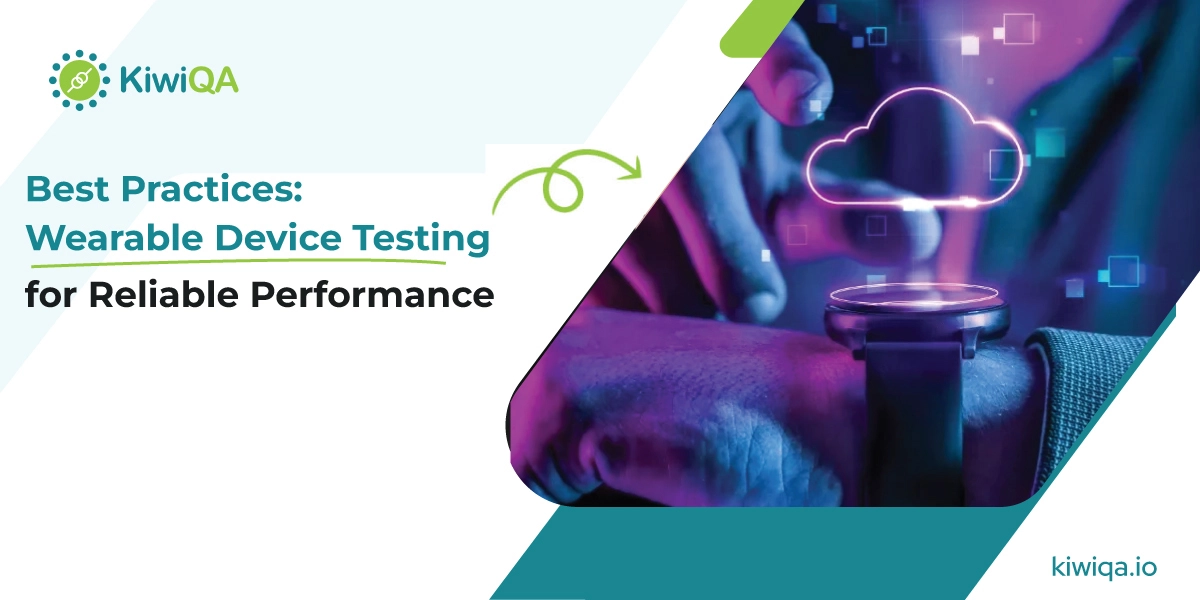Best Practices: Wearable Device Testing for Reliable Performance

 KiwiQA
KiwiQATable of Contents
With the advent of technological surge, wearable devices are becoming increasingly popular these days. Whether it is the healthcare sector or the fitness industry, the devices have made their place in many sectors. So, QA engineers are prioritizing wearable device testing to overcome the challenges to increase the performance and reliability of these electronic devices.
Let’s discuss the importance of testing for wearable devices, key areas to focus on, and best practices to tackle challenges to successfully optimize the testing process.
Wearable health devices are great for tracking the results of our physical health, vital signs, and other health-related signs that are necessary to enhance our overall health performance. So, wearable testing services here play a significant role in accurately measuring all the signs to meet real-world problems and user satisfaction.
Before briefly examining the importance of wearable devices, one should know about wearable device testing and its types.
Wearable testing or testing of wearable devices such as fitness trackers, smart watches, or location trackers should have undergone several testing processes, including functional, UI, compatibility, and other testing methodologies, to meet real-life scenarios and provide accurate testing results about your body’s vital health signs.
Wearable devices are advanced electronic devices that are capable of tracking real-time scenarios that can be worn on our body parts and connected to our mobile or laptops to provide results of our body symptoms. The devices coming under this category include:
Here comes the crucial part of knowing the importance of the wearable testing process in ensuring accuracy in wearable device testing such as:
Let’s discuss how to test wearable devices effectively by applying several testing methodologies and focusing on different testing areas.
While talking about functional testing services play an important role in checking the overall functionality of various testing methodologies, such as –
Another part of functionality testing services includes checking the integration for any software and hardware compatibilities by outlining the project requirements and accessibilities to several new functionalities that contribute to overall business profit.
Performance testing is one of the major testing methodologies used to check the overall performance of wearables when optimizing wearable device testing processes. These are performed to check:
1. Load testing: The load testing determines the amount of stress the device can take on itself by virtually allowing multiple users to work on several functionalities simultaneously.
2. Stress Testing: It is one of the effective wearable device testing techniques that determine the device’s behavior in extreme conditions to know the breaking points where the device may fail to respond and provide solutions to resolve them.
3. Soak testing: The significance of soak testing is to find out the issues that may happen after using it many times in the long run to ensure the device’s stability.
4. Spike Testing: The testing determines the device’s system ability to check whether the device’s internal setting is scalable enough to adapt to new technology changes as per the user demand.
It is a type of reliable testing method for wearable devices to test the usability of the developed wearable devices by the end users. For the best practices of UX testing, the following steps can be applied such as:
Security testing is a must-step for testers to provide the utmost security for the device’s internal functionalities along with the user’s data. The motive of the testing includes:
1. The security testing services must provide the user’s input data.
As wearable devices need to be connected to their mobile or laptops, which contain sensitive data, there is a chance of data loss. So, checking databases and cross-site scripting helps protect against other cyber-attacks.
The testing can be done in several methodologies, including:
2. Major security or vulnerabilities associated with wearable devices and solutions are –
The main topic of this blog is wearable device quality assurance practices to maximize the functionality and durability of wearable devices in real-world scenarios. Let’s discuss these practices thoroughly.
To determine the wearable device testing, the best practice should include the test in real-world scenarios such as:
For actual usage conditions, the testers should follow the following steps such as-
Automated tools are important while performing wearable testing services to enhance the testing process and provide the outcome with minimum risk. Let’s discuss some of the advantages and popular tools to test your wearable devices.
The popular tools and software used to test wearable device testing include:
Manual testing of wearable devices is an important part of the testing objectives that help in many ways performed by the human testers. Let’s discuss the importance and the applicable area.
There are several situations where manual testing is mandatory, such as exploratory testing, beta testing, user acceptance testing, ad-hoc testing, beta testing, error guessing, and other complex parts of the testing.
Other situations where human interventions are necessary include determining the product quality, installing the automation tools and their setup process, and discussing the feedback to act on them. This is when manual testing comes to the frame. Also, some manual testing tools are available to run the test cases.
One of the key approaches to wearable device testing is continuously testing the test cases on every code change and looking for feedback to implement this. Let’s find out how the technique helps in providing the best outcomes.
To make your wearable device error-free and from other malfunctions regular updates of the key functionalities help to minimize the bugs or unauthorized access that may enter the device prototypes to steal the users’ data and harm the device’s functionalities.
So, the testers should always regularly monitor the testing cycles by using several automatic testing tools that check the feedback and changes that may be required to upgrade the features to meet the user’s expectations.
For a better understanding of testing objectives and goals, testers should always rely on user feedback and act on it to reduce any kind of future dissatisfaction that may be faced by the end users that affect customer satisfaction.
To improve the feedback loop, human testers take the help of automatic testing methods to maximize the test coverage in every stage of development providing better feedback and analysis reports to enhance the productivity of the final product. Many testers are also incorporating these methods to test the wearable devices’ functionalities.
In the world of wearable technology, gadgets like fitness trackers and wearables have become essential companions, giving users information about their everyday activities and health. However, programmers face particular difficulties specific to each kind of wearable when they set out to integrate apps with these devices.
Though there are many practical uses for these tiny devices, creating wearable applications is challenging. We will go over some of the main issues that programmers of wearable apps are now facing with their apps.
Do you know the applications for which consumer more battery is rejected by the app stores? The battery capacity lowers down based on the device size. The battery consumption increases when multiple functions operate in the background. The developers must deal with this issue to design a battery-efficient solution for wearable app development.
The most necessary factor to look for when testing for wearable devices is battery usage & memory. Users always choose an application that consumes less power & memory. It also improves the application that is being removed since no one keeps updating their application. Wearable gadgets have small batteries, and that’s why you should be concerned about battery consumption.
To solve this issue, you have to develop an application that consumes energy in a balanced manner. Design a wearable application that is straightforward. While developing the application, the developer must personalize the code to consume less power and memory space. The wearable device that consumes less power and space performs better.
Interoperability issues arise when differences in data formats, standards & protocols between multiple technology & EHR systems. Multiple wearable devices & health applications are designed to comply with interoperable standards, for example, FHIR & HL7, ensuring that the information they produce will be easily exchanged & understood across multiple healthcare systems.
The common changes that arise in interoperability in IoT are a lack of standardization, security concerns, limited resources, and data management. Since the IoT landscape continues evolving, interoperability remains necessary. This is the key to enabling next-gen IoT solutions to drive innovation across various industries.
To ensure smooth data integration and transfer, specific data standards and interoperability standards like HL7 FHIR must be followed.
Numerous wearable apps experience data privacy breaches on a daily basis. Consequently, privacy is a critical consideration for wearable app development firms at every stage of the process. Data on health metrics, daily habits, and location details are generated through such devices. The wearable device comes with a sensor that is used to collect, store & transmit the biometric user data. The following data is basically sent to the smartphone, tablet & cloud-based platforms.
Updates & improvements are essential to the creation of wearable app technology. The support and development teams are always faced with the task of adding new features and being able to address any bugs that come up.
This implies that you must locate a trustworthy wearable development agency that can provide you with continuous assistance for the most recent wearable app updates. The possibility of threats and bugs is widely increasing, and that’s why concerns on behalf of security and data privacy are necessary.
A protected wearable device ensures long-term connections, improves interaction, and retains customers. To boost customer trust, wearable app developers need to take into account efficient security techniques. Apps should have sophisticated security features to safeguard sensitive data. They might select effective communication and precise privacy settings to maximize the whole experience.
Also, the program has to receive frequent improvements in safety. Every other day, professionals in this field create quick, profitable, and efficient changes. In this situation, the app needs to stay aware of advanced features & technologies. By successfully integrating robust security measures and compliance with regulations, the security and privacy issues can be resolved.
One in three Americans uses wearable technology! According to reports, thirty percent of people on the planet will own wearable technology by 2025. It is anticipated that wearable app development technologies will generate more than $70 billion in revenue. These statistics show the future of wearable devices and the necessity of development and testing.
The development of wearable technology presents new difficulties for designers and programmers to solve. This is where guidelines for wearable device testing are useful. However, every obstacle offers a different chance for you to build wearables with improved usability, accessibility, and seamless functioning.
Simplifying the layout for wearable devices is the most important thing to remember. By concentrating on the above-discussed content, several best practices and obstacles have been covered. Make use of these to improve your wearable design.
Join the like-minded community & get the latest updates and insights on software testing technological transformation around the globe. Don't miss out.
